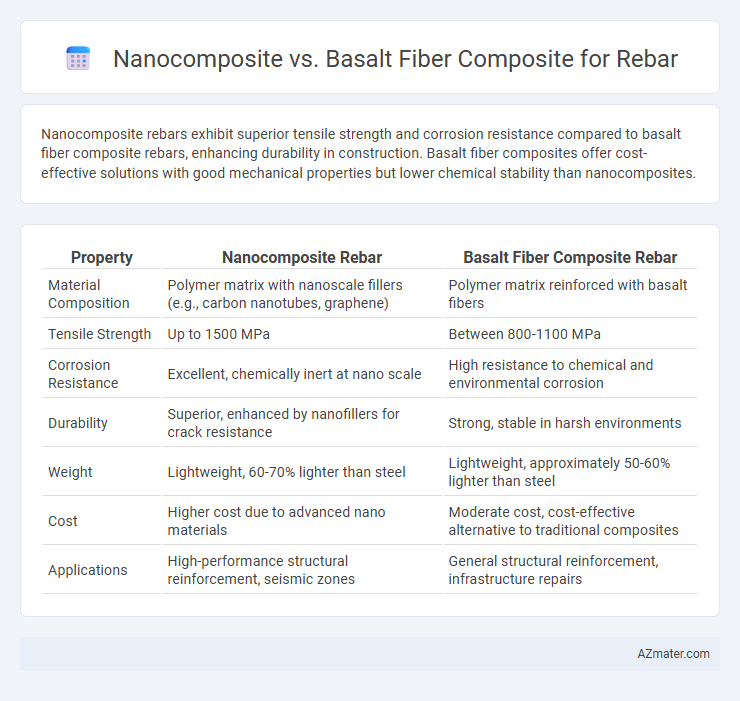Nanocomposite rebars exhibit superior tensile strength and corrosion resistance compared to basalt fiber composite rebars, enhancing durability in construction. Basalt fiber composites offer cost-effective solutions with good mechanical properties but lower chemical stability than nanocomposites.
Table of Comparison
| Property | Nanocomposite Rebar | Basalt Fiber Composite Rebar |
|---|---|---|
| Material Composition | Polymer matrix with nanoscale fillers (e.g., carbon nanotubes, graphene) | Polymer matrix reinforced with basalt fibers |
| Tensile Strength | Up to 1500 MPa | Between 800-1100 MPa |
| Corrosion Resistance | Excellent, chemically inert at nano scale | High resistance to chemical and environmental corrosion |
| Durability | Superior, enhanced by nanofillers for crack resistance | Strong, stable in harsh environments |
| Weight | Lightweight, 60-70% lighter than steel | Lightweight, approximately 50-60% lighter than steel |
| Cost | Higher cost due to advanced nano materials | Moderate cost, cost-effective alternative to traditional composites |
| Applications | High-performance structural reinforcement, seismic zones | General structural reinforcement, infrastructure repairs |
Introduction to Composite Rebars
Composite rebars combine high-performance materials to enhance structural durability and corrosion resistance in concrete reinforcement. Nanocomposites integrate nanoscale fillers into polymer matrices, offering superior mechanical strength and improved bond characteristics compared to conventional composites. Basalt fiber composites leverage natural basalt fibers, providing excellent tensile strength, thermal stability, and eco-friendly properties, making them a competitive alternative to traditional steel and carbon fiber rebars.
Overview of Nanocomposite Materials
Nanocomposite materials for rebar incorporate nanoparticles such as carbon nanotubes or graphene into a polymer or cementitious matrix, significantly enhancing mechanical strength, durability, and corrosion resistance compared to traditional composites. These materials exhibit superior load transfer efficiency and improved fracture toughness, making them ideal for structural reinforcement in aggressive environments. Their nanoscale reinforcements provide enhanced bonding with the matrix, reducing micro-crack propagation and extending the lifespan of rebar applications.
Understanding Basalt Fiber Composites
Basalt fiber composites, derived from natural volcanic basalt rock, offer superior mechanical strength, chemical resistance, and thermal stability compared to traditional materials used in rebar applications. These composites enhance durability against corrosion and environmental degradation, making them ideal for reinforcing concrete structures exposed to harsh conditions. Their lightweight nature combined with high tensile strength improves structural performance while reducing overall construction costs and maintenance.
Mechanical Properties Comparison
Nanocomposite rebars exhibit significantly higher tensile strength and improved fatigue resistance compared to basalt fiber composites, making them ideal for demanding structural applications. Basalt fiber composites offer moderate mechanical performance with excellent impact resistance and superior corrosion durability, which enhances longevity in harsh environments. The increased stiffness and enhanced load-bearing capacity of nanocomposite rebars provide a distinct advantage in high-performance construction projects requiring lightweight yet robust reinforcement materials.
Corrosion Resistance: Nanocomposite vs Basalt Fiber
Nanocomposite rebars exhibit superior corrosion resistance due to their nanoscale filler dispersion, which creates a dense barrier against moisture and chemical ingress. Basalt fiber composites provide good corrosion resistance by naturally resisting chemical attacks and moisture absorption, but they may develop micro-cracks over time under harsh conditions. Compared to basalt fiber, nanocomposites demonstrate enhanced durability in aggressive environments, making them more reliable for long-term rebar applications.
Durability and Lifespan in Harsh Environments
Nanocomposite rebars demonstrate superior durability in harsh environments due to their enhanced resistance to corrosion, UV radiation, and chemical exposure compared to basalt fiber composites. The nanomaterials within the matrix improve mechanical properties and inhibit moisture penetration, extending the lifespan of nanocomposite rebars significantly over basalt fiber alternatives. Basalt fiber composites, while offering good tensile strength and alkali resistance, typically exhibit faster degradation under acidic or highly saline conditions, reducing their effective service life.
Cost-Effectiveness and Availability
Nanocomposite rebars offer enhanced mechanical properties but generally come with higher production costs due to advanced materials and manufacturing processes. Basalt fiber composites provide a cost-effective alternative with widely available raw materials and lower energy consumption in production, making them more accessible for large-scale construction projects. The cost-effectiveness and availability of basalt fiber composite rebar position it as a practical choice where budget constraints and material sourcing are critical factors.
Sustainability and Environmental Impact
Nanocomposite rebars exhibit superior sustainability by integrating nano-sized reinforcements that reduce material usage and enhance durability, lowering overall carbon footprint compared to traditional materials. Basalt fiber composite rebars offer eco-friendly benefits through the use of natural basalt rock, which requires less energy to produce and provides high corrosion resistance, extending structural lifespan and reducing maintenance needs. Both materials promote environmental impact reduction, but basalt fiber composites often present a more renewable sourcing advantage while nanocomposites deliver improved performance with potentially longer service life.
Real-World Applications and Performance
Nanocomposite rebars exhibit enhanced corrosion resistance and superior tensile strength, making them ideal for infrastructures exposed to harsh environments like marine and coastal constructions. Basalt fiber composites offer excellent fire resistance and high durability, commonly applied in seismic retrofitting and bridge reinforcement due to their lightweight nature and ease of installation. Performance evaluations reveal nanocomposites provide longer service life with reduced maintenance costs, whereas basalt fiber composites deliver cost-effective solutions with robust mechanical properties suitable for large-scale civil engineering projects.
Future Prospects and Innovations
Nanocomposite rebars exhibit superior mechanical properties and enhanced corrosion resistance compared to basalt fiber composites, positioning them as a frontrunner in advanced construction materials. Innovations in nanomaterial functionalization and hybrid fiber integration promise to further improve tensile strength and durability while reducing material weight and cost. Future prospects include the development of smart rebars with embedded sensors for real-time structural health monitoring, revolutionizing infrastructure longevity and safety.

Infographic: Nanocomposite vs Basalt fiber composite for Rebar
 azmater.com
azmater.com